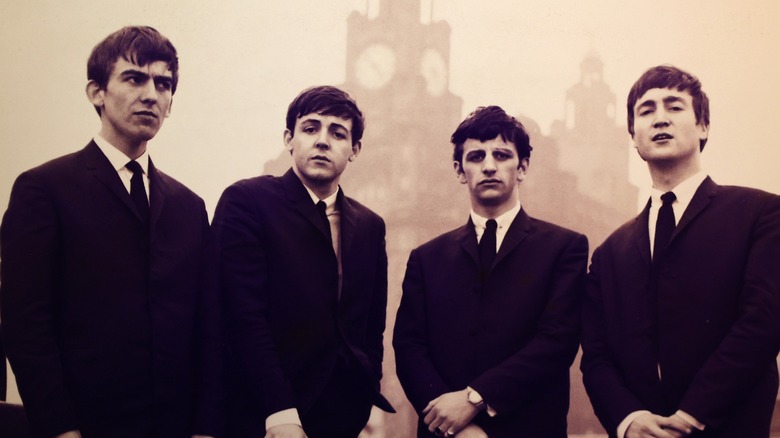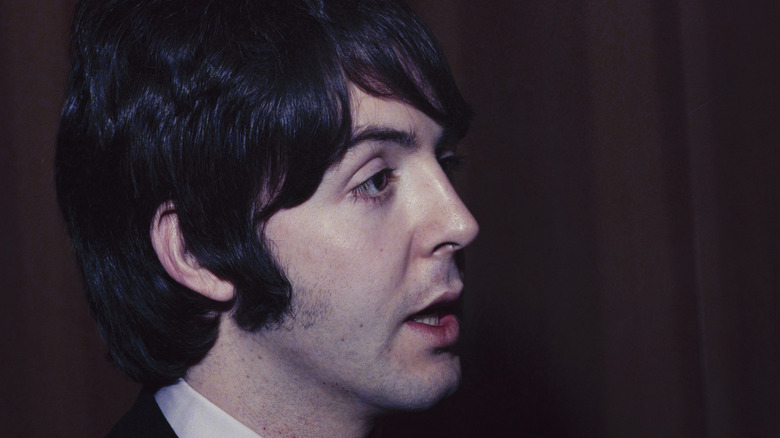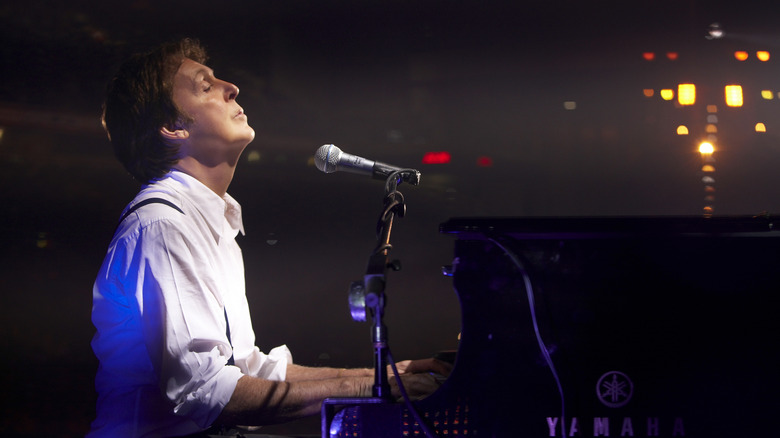The Tragic Inspiration For 'Let It Be' By The Beatles
The Beatles' ballad "Let It Be" was first released back in 1970, as a single of the album of the same name. The last single of the band's career until the release of those with the "Anthology" project in the 1990s, "Let It Be" topped the Billboard Hot 100 in the U.S. and hit No. 1 in several other countries. Since then, it has remained one of The Beatles' most iconic and well-loved songs, with its stoic message and seemingly spiritual lyrics making it a favorite for live cover versions and religious ceremonies such as weddings and funerals. But while "Let It Be" remains popular, the tragic inspiration behind it remains comparatively unknown among most Beatles fans.
"Let It Be" is credited to songwriters John Lennon and Paul McCartney, but was almost entirely the work of the latter. "I don't know what he's thinking when he writes 'Let it Be,'" Lennon later said (via Beatles Bible). "He probably heard a gospel song." But years later, McCartney himself revealed the song was about his mother, who had died when he was just a teenager, but who McCartney says came to him in a vision when he was at a low ebb and in need of advice.
McCartney's dream of mother Mary
Paul McCartney's "Let It Be" first emerged during a difficult period for The Beatles and was a reflection of increasing tensions between McCartney and the other members of the band. It was January 1969, when the Fab Four were in the studio to work on the "Get Back" project, a planned TV special that Paul McCartney believed would help bring the band back to its roots.
John, Paul, George, and Ringo had begun to drift apart during the recording of 1968's "The Beatles," aka "The White Album," with the band members often writing and recording separately, and with them each pursuing distinct interests. John Lennon was consumed by his love affair with the artist Yoko Ono, while George Harrison persisted in his interest in spirituality and religion and developing his own songwriting skills. The band had also been shaken by several traumatic events, including the death of their manager Brian Epstein in August 1967, as well as their fractious break with the religious leader Maharishi Mahesh Yogi, whom they had visited in India in 1968.
Around this time, McCartney, perhaps worrying about the future of the band he had dedicated his life to, had a profound experience when his mother, Mary, came to him in a dream. Mary McCartney had died tragically of complications of breast cancer when McCartney was just 14. A decade later, she told him in his dream not to worry about the trouble around him, but simply to "let it be."
A supernatural vision, or the subconscious speaking?
Paul McCartney has not shied away from the more mystical experiences that underpin some of his most beloved songs, and neither does he avoid discussing what his vision of his mother meant to him when he was finding being a Beatle a challenge. Speaking to Barry Miles for the biography "Many Years From Now," McCartney recalled: "It was so great to see her because that's a wonderful thing about dreams: you actually are reunited with that person for a second; there they are and you appear to both be physically together again. It was so wonderful for me and she was very reassuring ... It was such a sweet dream I woke up thinking, Oh, it was really great to visit with her again. I felt very blessed to have that dream."
McCartney has recently released a podcast series, "McCartney: A Life in Lyrics," in which he talks to the poet Paul Muldoon about the inspiration for his most famous songs and the circumstances that brought them into being. Muldoon suggests that the incident could be interpreted as supernatural, but McCartney instead sees his vision of Mary as a reflection of his subconscious, which drew on his comforting memory of his mother to ease him when he was feeling particularly alone and vulnerable, which reminded him that he despite everything he was safe and loved. "It's me saying it through her," McCartney explains.
Other inspirations for Let It Be
John Lennon was correct that "Let It Be" is a song in the gospel tradition. Indeed, the song has such a connection to devotional music that it has become a favorite of gospel groups and other performers of devotional music around the world. However, McCartney claims no direct gospel influence motivated him during the writing of the song, though he recalls that writing "Let It Be" began with the phrase "Mother Mary," which has a religious double meaning and that the song certainly evokes a Christian image.
Lennon also guessed erroneously that Paul McCartney might have taken inspiration from Simon and Garfunkel's classic ballad "Bridge Over Troubled Water" in the composition of "Let It Be," though as fans of the song have pointed out McCartney's song was first recorded a year before Simon and Garfunkel's. Similarly, on the "A Life in Lyrics" podcast, Paul Muldoon has pointed out a similarity to the classic song "Whatever Will Be, Will Be (Que Sera Sera), though McCartney denies any direct lineage. Instead, he suggests that he may have remembered a line from William Shakespeare's "Hamlet," which he'd studied at school and which he may have been reading around the time of his mother's death. McCartney points to Act Five, Scene Two, in which Hamlet, realizing that his death was near, tells his ally Horatio, in an expression of stoicism, to "let it be."


